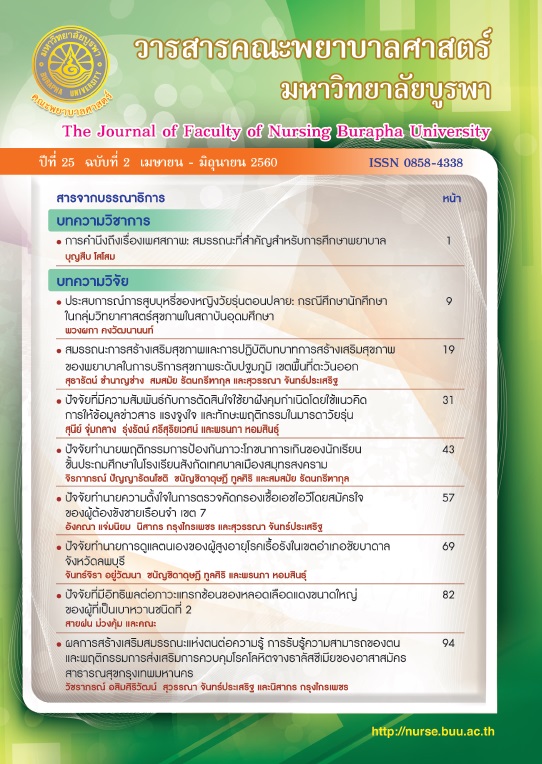ปัจจัยที่มีอิทธิพลต่อภาวะแทรกซ้อนของหลอดเลือดแดงขนาดใหญ่ ของผู้ที่เป็นเบาหวานชนิดที่ 2 (Factors Influencing Macrovascular Complications among Persons with Type 2 Diabetes)
คำสำคัญ:
ภาวะแทรกซ้อนหลอดเลือดแดงขนาดใหญ่, เบาหวานชนิดที่ 2, คาดัชนีสัดส่วนระหว่างความดันซีสโตลิกที่ข้อเท้ากับความดันซีสโตลิกที่แขน, คาดัชนีความยืดหยุนของหลอดเลือดแดง,บทคัดย่อ
บทคัดย่อ
การวิจัยนี้เป็นการศึกษาแบบภาคตัดขวาง เพื่อศึกษาความชุก และปัจจัยที่มีอิทธิพลกับการเกิดภาวะแทรกซ้อนของหลอดเลือดแดงขนาดใหญ่ ในผู้ที่เป็นเบาหวานชนิดที่ 2 จำนวนตัวอย่าง 350 ราย โดยเก็บข้อมูลด้วยแบบสอบถาม ประกอบด้วยข้อมูลส่วนบุคคล ประวัติการเจ็บป่วย และผลตรวจทางห้องปฏิบัตการ ในคลินิกเบาหวาน แผนกผู้ป่วยนอก โรงพยาบาลของรัฐ 11 แห่งในเขตภาคตะวันออก วิเคราะห์ข้อมูลด้วยสถิติเชิงพรรณนา และสถิติถดถอยพหุแบบลอจิสติค
ผลการวิจัย พบว่า ผู้ป่วยเบาหวาน 169 ราย มีภาวะแทรกซ้อนของหลอดเลือดแดงขนาดใหญ่ คิดเป็นอัตราความชุกเท่ากับร้อยละ 48.28 และปัจจัยที่มีอิทธิพลกับการเกิดภาวะแทรกซ้อนของหลอดเลือดแดงขนาดใหญ่อย่างมีนัยสำคัญทางสถิติ ได้แก่ เพศชาย (OR = 2.24) ผู้ที่มีอายุ 80 ปีขึ้นไป
(OR = 14.03) ระยะเวลาการเป็นเบาหวานมากกว่า 20 ปี (OR = 4.77) และค่าความดันซีสโตลิกที่เพิ่มขึ้นทุก ๆ 1 มิลลิเมตรปรอท (OR = 1.02) รวมไปถึงผู้ที่มีระดับน้ำตาลสะสมในเลือดปกติ และดัชนีมวลกายอยู่ในระดับปกติกลับพบว่ามีโอกาสเกิดภาวะแทรกซ้อนมากขึ้น โดยปัจจัยทั้งหมดร่วมทำนายโอกาสเกิดภาวะแทรกซ้อนได้ 23.3% จากผลการวิจัย พยาบาลควรประเมินการไหลเวียนหลอดเลือดแดงส่วนปลายอย่างต่อเนื่องให้กับผู้เป็นเบาหวานอย่างน้อยปีละ 1 ครั้ง โดยเฉพาะอย่างยิ่งผู้ที่เป็นเบาหวานมากกว่า 5 ปี ผู้สูงอายุ และผู้ที่มีภาวะความดันโลหิตสูงร่วมด้วย เพื่อชะลอการเกิดภาวะแทรกซ้อนหลอดเลือดแดงขนาดใหญ่
Abstract
This cross-sectional study aimed to estimate the prevalence of macrovascular complications and its influencing factors in Type 2 Diabetes patients. Three hundred and fifty participants from a visiting out-patient diabetes clinic of 11 governmental hospitals in the eastern region of Thailand were involved in the study. personal data, history of illness, and history of the laboratory were collected using our approval record forms. Descriptive statistics and multiple logistic regressions were used to descript and to identify factors associated with macrovascular complications.
There were 168 of 350 cases having the macrovascular complications and the prevalence was 48.00% (95%CI: 42.74% to 52.36%). In the multivariate model, factors significantly influenced with macrovascular complications were male (OR = 2.24), age > 80 years old (OR = 14.03), diabetes patients who have diabetes more than 20 years
(OR = 4.77), and increasing in systolic blood pressure every 1 mmHg (OR = 1.02). Moreover, we found that the diabetes patients who have a normal level of HbA1C and BMI have more risk of macrovascular complications. The macrovascular complications can be predicted by those factors 23.3%. The implication for nursing practice from this finding is that nurses need to regularly examined for peripheral arterial disease and artery stiffness at least once a year, especially those who having diabetes longer than 5 years, elderly people, and those who having high blood pressure in order to postpone the occurrence of the complications of macrovascular.





